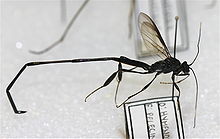Wasp-like
| Wasp-like | ||||||||||
|---|---|---|---|---|---|---|---|---|---|---|

Illustration of a representative of the Proctotrupidae |
||||||||||
| Systematics | ||||||||||
|
||||||||||
| Scientific name | ||||||||||
| Proctotrupoidea | ||||||||||
| Latreille , 1802 |

The Proctotrupoidea as to the type family proctotrupoidea called, are a superfamily of Hymenoptera .
features
The superfamily in the modern sense is primarily defined and delimited on the basis of the results of molecular phylogeny, on the basis of the correspondence of homologous DNA sequences. Morphological autapomorphies cannot be given. They are predominantly small hymenoptera, only the Pelecinidae reach greater lengths (up to seven centimeters) due to their greatly elongated, narrow abdomen. Neither species possesses the metallic colors or striking pattern of most gold wasps . An exposed, elongated ovipositor is only present in the Vanhorniidae, otherwise it is either hidden in the abdomen or enclosed in a widened, heavily sclerotized sheath. It always sits at the end of the abdomen and is not displaced on the ventral side (ventrad), but is often curved in this direction.
Systematics
The superfamily in the modern sense was defined by Michael Sharkey in 2007, who built on the work of Alexandr Rasnitsyn in 1980 and Ian D. Naumann and Lubomir Masner in 1985. The group so defined was included in the most recent systematic review of the hymenoptera.
According to this view, the following families belong to the Proctotrupoidea:
- Austroniidae Kozlov, 1975
- Heloridae Forester, 1856
- Pelecinidae Haliday, 1839
- Peradeniidae Naumann & Masner, 1985
- Proctorenyxidae Lelej & Kozlov, 1999
- Proctotrupidae Latreille, 1802
- Roproniidae Bradley, 1905
- Vanhorniidae Crawford, 1909
also three extinct families that are only preserved as fossils:
- Iscopinidae Rasnitsyn, 1980
- Jurapriidae Rasnitsyn, 1983
- Mesoserphidae Kozlov, 1970
According to Rasnitsyn's view, the Proctotrupoidea are a group of roots from which the Chalcidoidea , Cynipoidea and Diaprioidea have probably split off in the chalk , they would therefore be paraphyletic (since Rasnitsyn does not hold a strictly cladistic view, it does not matter to him). More recent investigations into molecular phylogeny have, however, been able to confirm the group defined in this way essentially as a monophyletic unit. The group is often referred to as the Proctotrupoidea in the narrower sense (sensu stricto). Since not all families were tested simultaneously in the analyzes, and some very rare families even not at all, the exact delimitation of the superfamily is currently still uncertain. This mainly affects the Austroniidae, which could also belong to the Diaprioidea.
Earlier editors have made the superfamily much more distinct. It was often viewed as an embarrassment or trash taxon into which all the families of the "microhymenoptera" were sorted that did not find a place in the better-defined superfamilies. The Ceraphronoidea (with the families Megaspilidae and Ceraphronidae ) have been recognized as not belonging here for a long time. Next, the Scelionidae and Platygastridae were spun off as the superfamily Platygastroidea . However, many more recent editors also left the Diapriidae and the small families Monomachidae and Maamingidae with the wasps , which are understood in the more recent edits as the superfamily Diaprioidea . The families, which can hardly be distinguished morphologically, are more closely related to the golden wasps than to the remaining wasps in terms of their molecular pedigrees.
According to morphological and molecular analyzes, all of the superfamilies mentioned here probably form a common kin group, the Proctotrupomorpha. The exact sister group relationships within this clade are still uncertain and contradictory between the various analyzes and cannot be specified with sufficient certainty today.
Species numbers
The wasps are a relatively poor superfamily. The only moderately species-rich group are the wasps themselves with around 400 living species. The other seven families together come to just under 50. The family has been fossilized since the early Jurassic and is therefore one of the earliest fossil-based Apocrita . Numerous fossil species are known from all over the world.
Individual evidence
- ↑ Michael J. Sharkey (2007): Phylogeny and Classification of Hymenoptera. Zootaxa 1668: 521-548.
- ^ AP Rasnitsyn (1980): Origin and evolution of Hymenoptera. Trudy Paleontologicheskogo Instituta Akademii Nauk SSSR 174: 1–192 (in Russian).
- ↑ ID Naumann & L.Masner (1985): Parasitic wasps of the Proctotrupoid complex: a new family from Australia and a key to world families (Hymenoptera, Proctotrupoidea sensu lato). Australian Journal of Zoology 33 (5): 761 - 783. doi : 10.1071 / ZO9850761
- ↑ a b Alexandre P. Aguiar et al. (2013): Order Hymenoptera. In: Zhang, Z.-Q. (Editor): Animal Biodiversity: An Outline of Higher-level Classification and Survey of Taxonomic Richness (Addenda 2013). Zootaxa, 3703, 1-82.
- ↑ John Heraty, Fredrik Ronquist, James M. Carpenter, David Hawks, Susanne Schulmeister, Ashley P. Dowling, Debra Murray, James Munro, Ward C. Wheeler, Nathan Schiff, Michael Sharkey (2011): Evolution of the hymenopteran megaradiation. Molecular Phylogenetics and Evolution 60: 73-88. doi : 10.1016 / j.ympev.2011.04.003
- ↑ Seraina Klopfstein, Lars Vilhelmsen, John M. Heraty, Michael Sharkey, Fredrik Ronquist (2013): The Hymenopteran Tree of Life: Evidence from Protein-Coding Genes and Objectively Aligned Ribosomal Data. PLoS ONE 8 (8): e69344. doi : 10.1371 / journal.pone.0069344
- ↑ Ansel Payne, Phillip M. Barden, Ward C. Wheeler, James M. Carpenter (2013): Direct optimization, sensitivity analysis, and the evolution of the hymenopteran superfamilies. American Museum Novitates Number 3789.
- ↑ David Grimaldi & Michael S. Engel: Evolution of the Insects. Cambridge University Press, 2005.